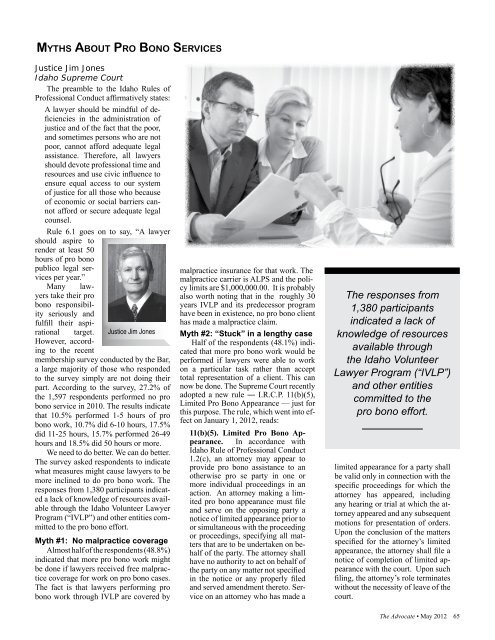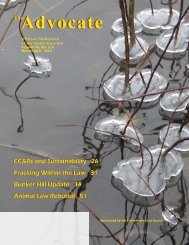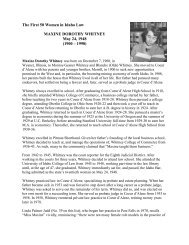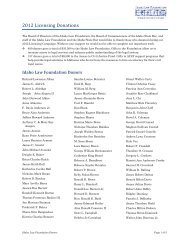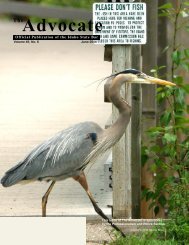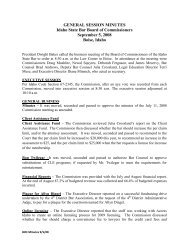The Advocate - May 2012 - Idaho State Bar - Idaho.gov
The Advocate - May 2012 - Idaho State Bar - Idaho.gov
The Advocate - May 2012 - Idaho State Bar - Idaho.gov
Create successful ePaper yourself
Turn your PDF publications into a flip-book with our unique Google optimized e-Paper software.
My t h s aB o u t Pr o Bo n o se rv i C e s<br />
Justice Jim Jones<br />
<strong>Idaho</strong> Supreme Court<br />
<strong>The</strong> preamble to the <strong>Idaho</strong> Rules of<br />
Professional Conduct affirmatively states:<br />
A lawyer should be mindful of deficiencies<br />
in the administration of<br />
justice and of the fact that the poor,<br />
and sometimes persons who are not<br />
poor, cannot afford adequate legal<br />
assistance. <strong>The</strong>refore, all lawyers<br />
should devote professional time and<br />
resources and use civic influence to<br />
ensure equal access to our system<br />
of justice for all those who because<br />
of economic or social barriers cannot<br />
afford or secure adequate legal<br />
counsel.<br />
Rule 6.1 goes on to say, “A lawyer<br />
should aspire to<br />
render at least 50<br />
hours of pro bono<br />
publico legal services<br />
per year.”<br />
Many lawyers<br />
take their pro<br />
bono responsibility<br />
seriously and<br />
fulfill their aspirational<br />
target.<br />
However, according<br />
to the recent<br />
Justice Jim Jones<br />
membership survey conducted by the <strong>Bar</strong>,<br />
a large majority of those who responded<br />
to the survey simply are not doing their<br />
part. According to the survey, 27.2% of<br />
the 1,597 respondents performed no pro<br />
bono service in 2010. <strong>The</strong> results indicate<br />
that 10.5% performed 1-5 hours of pro<br />
bono work, 10.7% did 6-10 hours, 17.5%<br />
did 11-25 hours, 15.7% performed 26-49<br />
hours and 18.5% did 50 hours or more.<br />
We need to do better. We can do better.<br />
<strong>The</strong> survey asked respondents to indicate<br />
what measures might cause lawyers to be<br />
more inclined to do pro bono work. <strong>The</strong><br />
responses from 1,380 participants indicated<br />
a lack of knowledge of resources available<br />
through the <strong>Idaho</strong> Volunteer Lawyer<br />
Program (“IVLP”) and other entities committed<br />
to the pro bono effort.<br />
Myth #1: No malpractice coverage<br />
Almost half of the respondents (48.8%)<br />
indicated that more pro bono work might<br />
be done if lawyers received free malpractice<br />
coverage for work on pro bono cases.<br />
<strong>The</strong> fact is that lawyers performing pro<br />
bono work through IVLP are covered by<br />
malpractice insurance for that work. <strong>The</strong><br />
malpractice carrier is ALPS and the policy<br />
limits are $1,000,000.00. It is probably<br />
also worth noting that in the roughly 30<br />
years IVLP and its predecessor program<br />
have been in existence, no pro bono client<br />
has made a malpractice claim.<br />
Myth #2: “Stuck” in a lengthy case<br />
Half of the respondents (48.1%) indicated<br />
that more pro bono work would be<br />
performed if lawyers were able to work<br />
on a particular task rather than accept<br />
total representation of a client. This can<br />
now be done. <strong>The</strong> Supreme Court recently<br />
adopted a new rule ― I.R.C.P. 11(b)(5),<br />
Limited Pro Bono Appearance — just for<br />
this purpose. <strong>The</strong> rule, which went into effect<br />
on January 1, <strong>2012</strong>, reads:<br />
11(b)(5). Limited Pro Bono Appearance.<br />
In accordance with<br />
<strong>Idaho</strong> Rule of Professional Conduct<br />
1.2(c), an attorney may appear to<br />
provide pro bono assistance to an<br />
otherwise pro se party in one or<br />
more individual proceedings in an<br />
action. An attorney making a limited<br />
pro bono appearance must file<br />
and serve on the opposing party a<br />
notice of limited appearance prior to<br />
or simultaneous with the proceeding<br />
or proceedings, specifying all matters<br />
that are to be undertaken on behalf<br />
of the party. <strong>The</strong> attorney shall<br />
have no authority to act on behalf of<br />
the party on any matter not specified<br />
in the notice or any properly filed<br />
and served amendment thereto. Service<br />
on an attorney who has made a<br />
<strong>The</strong> responses from<br />
1,380 participants<br />
indicated a lack of<br />
knowledge of resources<br />
available through<br />
the <strong>Idaho</strong> Volunteer<br />
Lawyer Program (“IVLP”)<br />
and other entities<br />
committed to the<br />
pro bono effort.<br />
limited appearance for a party shall<br />
be valid only in connection with the<br />
specific proceedings for which the<br />
attorney has appeared, including<br />
any hearing or trial at which the attorney<br />
appeared and any subsequent<br />
motions for presentation of orders.<br />
Upon the conclusion of the matters<br />
specified for the attorney’s limited<br />
appearance, the attorney shall file a<br />
notice of completion of limited appearance<br />
with the court. Upon such<br />
filing, the attorney’s role terminates<br />
without the necessity of leave of the<br />
court.<br />
<strong>The</strong> <strong>Advocate</strong> • <strong>May</strong> <strong>2012</strong> 65


